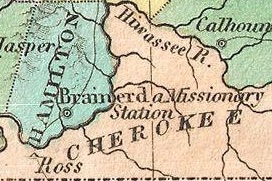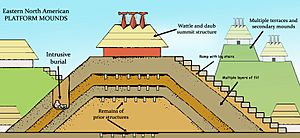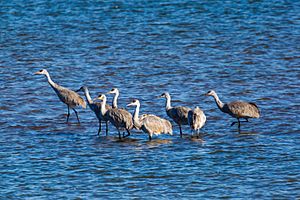Hiwassee Island facts for kids
Hiwassee Island, also known as Jollys Island, is a special place in Meigs County, Tennessee. It sits where the Tennessee River and Hiwassee River meet. This island is about 35 miles northeast of Chattanooga.
Long ago, Hiwassee Island was the second largest piece of land on the Tennessee River, covering 781 acres. But in 1940, the Tennessee Valley Authority (TVA) built the Chickamauga Lake dam. This caused much of the island to go underwater. Now, about 400 acres remain above the water.
People have lived on Hiwassee Island for a very long time. This includes groups from the Archaic and Woodland periods. A large village of the Mississippian culture was here, starting in the 11th century. Later, in the 1800s, it was a Cherokee village with about 300 people. Chief John Jolly led this village. Famous American Sam Houston even lived there for three years!
Today, the island is a resting spot for many birds. It used to attract up to 20,000 sandhill cranes. Now, fewer than 1,000 cranes visit. A few hundred pelicans also stop here during their long journeys.
Contents
Ancient People on Hiwassee Island
Seventeen different Native American tribes have connections to Hiwassee Island. People lived on the island off and on for thousands of years. It was one of many places where Native Americans built large mounds of earth. These Mound Builder sites are found in the Chickamauga Reservoir Basin.
People started building mounds here between the 9th and 11th centuries. At one point, perhaps during the Late Woodland time, a wooden fence called a stockade surrounded the village.
At first, people hunted and gathered food. Later, they became farmers, growing maize (corn). This likely helped the island's population grow. Early pottery was made with limestone. But later, most pottery used crushed shells. The Cherokee people on the island made a special type of pottery called Hiwassee Island Complicated Stamp pottery. It was similar to pottery found in northern Georgia.
The Cherokee Village
The Cherokee people are thought to have started as a Woodland culture. Over time, they adopted some ways of the Mississippian culture. They began to interact with white settlers in the 1600s. The Cherokee originally lived in the mountains of North and South Carolina. They moved into Tennessee as white settlers arrived. The Cherokee also started to use some European tools and ideas.
Life in the Early Cherokee Village
After 1650, European settlement changed the lives of the Cherokee. Illnesses and conflicts reduced their population. Some villages were left empty. The Cherokee moved to areas with good land for farming and raising animals. They built fewer large mounds and meeting houses.
The Cherokee traded deerskins for many goods. These included garden tools, paint, clothes, beads, and even rum. They also traded for weapons, which made hunting deer easier. By the early 1700s, about 50,000 deerskins were sent from Charleston, South Carolina. These new weapons also helped them in battles.
In the late 1600s and early 1700s, the Cherokee on Hiwassee Island made shell gorgets (necklaces) and buried their dead in special pits. They used stones to build mounds. They also built earth lodges for ceremonies. Sometimes, they decorated shell gorgets with rattlesnake designs.
Later Cherokee Settlement
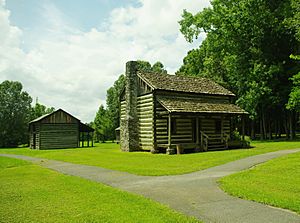
The last Native Americans to live on the island were a small group of Cherokee. They lived there from the late 1700s into the 1800s. Chief John Jolly (also called Oolooteeskee) led them.
In 1809, Sam Houston came to live with the Cherokee. He later married Jolly's niece, Diana Rogers Gentry. The Cherokee here grew corn. They also started to adopt some American ways. They created a constitution and signed treaties. They even printed a newspaper called the Phoenix.
By the early 1800s, the Cherokee had three main areas. These were the Ridge and Valley (or Overhill) towns, the Piedmont (or Lower Cherokee), and the Blue Ridge (or Middle Cherokee) districts. Hiwassee Island was in the Overhill area. The Overhill towns were in southeastern Tennessee, northwestern Georgia, and northeastern Alabama. Each area spoke a slightly different version of the Cherokee language. The Western or Otali dialect was spoken in the Overhill districts.
The Hiwassee Complicated Stamped pottery shows that Cherokee culture grew over a long time in the southern Appalachian region. This pottery is like the Southern Appalachian pottery of the Mississippian culture. It is very similar to the Etowah Complicated Stamped pottery from Georgia. The difference is that Hiwassee Island pottery used finely ground shell instead of sand. People made bowls and round jars. Using ground shell and having plain surfaces helped tell the pottery of the Overhill towns apart from other Cherokee areas.
Return J. Meigs Sr. was an Indian agent for the Cherokee from 1801 to 1823. He encouraged education, helping to start the Brainerd Mission in what is now Chattanooga. The Cherokee respected him at first. But they became upset as more white settlers moved onto their lands.
Because of this westward movement, the Cherokee tribe left the island in 1818. The Calhoun Treaty of 1819 gave the land to the United States. Most of the old village remains are now a few feet underground.
Cherokee Removal Memorial Park
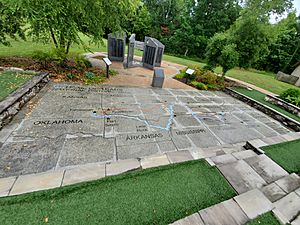
The Cherokee Removal Memorial Park is located near Dayton, Tennessee. It overlooks Hiwassee Island. This park was created to honor the friendship between Sam Houston and the Native Americans. These groups lived in Tennessee, Arkansas, and Oklahoma. The park is near where the Tennessee River and Hiwassee River meet.
Creeks and Yuchi People
Some historians believe that Creeks lived in eastern Tennessee by 1450. Both Creeks and Yuchi people were in the area by 1540. The Creeks stayed in this area until about 1700 to 1715.
The Mississippian Village
The Hiwassee Island and Dallas cultures were the main groups living on the island during the Middle Mississippian period. There might have been two other groups, Martin Farm (900 to 1100) and Mouse Creek (starting in the 1400s). These groups may have lived on the island at the same time as the Dallas culture.
Hiwassee Island Culture
People of the Hiwassee culture lived on the island starting in the 11th century. This group was part of the Early Middle Mississippian culture.
On the north end of the island, there was a four-acre village surrounded by a wooden fence. It had a central open area. Many houses were found under a large platform mound. This mound was 23 feet high and 148 feet wide at its base.
Large platform mounds began to be built by the 12th century. These mounds were bases for important buildings. Some mounds had several flat tops with multiple buildings. The Hiwassee Island culture lived in four stages. They built 30 rectangular buildings, mostly with walls made of small poles.
Pottery from this time includes Hiwassee Island Red Filmed and Hiwassee Island Red-on-Buff types. It is rare to find pottery painted red in the Eastern United States. Later, more red pottery was made. Instead of burying the dead in cone-shaped mounds, they were buried in the platform mounds. People also made more advanced tools, like special axes, and beautiful ornaments. These included engraved shell gorgets, headdresses, and copper decorations.
Dallas Culture
The Dallas Phase (about 1300–1600) was a later Middle Mississippian culture. These people are believed to be Creek Indians. This culture is named after the Dallas site, another old place in the Chickamauga Reservoir Basin. Some experts believe the village population grew later in the Dallas phase. This happened when a group moved up the Tennessee River.
The Dallas culture also lived in four stages. They built square buildings with log walls and four roof supports. Later, only buildings on top of the mounds were built with small posts. Other buildings used large posts for support.
In this phase, a single flat top replaced the multiple tops of the Hiwassee Island phase mounds. When people died, they were buried in or near their homes, or in the mound. One hundred eighty-eight people were buried near Dallas culture houses in rectangular pits. They were buried with stone and bone tools, pottery, shell beads, cups, and gorgets. The gorgets had many different designs.
The Dallas culture made more shell-tempered pottery with cord marks. They added handles to jars. They also made new types of pottery with animal shapes and carved designs.
There were times when the island seemed empty. For example, from the 13th to 14th century, fewer settlements were in the Chickamauga basin. The remaining settlements had larger mounds. This suggests that smaller groups of people joined together. Other Dallas Phase settlements were along the Tennessee River between Chattanooga and Knoxville. Other sites in the Chickamauga Reservoir Basin include the Davis, Hixon, and Sale Creek sites.
Archaic and Woodland Periods
The first people to live on the island were from the Archaic phase (about 377 to 1348 B.C.). After that, people from the Woodland period lived there.
Later Woodland groups, like the Hamilton focus, made pottery with clay mixed with limestone. They made pottery with cord marks and plain surfaces. Five burial mounds with 173 bodies and river-mussel shells are from the Late Woodland period. Cone-shaped burial mounds were used from the Late Woodland period until about 1200 A.D.
Island Excavation
Hiwassee Island was dug up by archaeologists between 1937 and 1939. This work was done by the Works Progress Administration (WPA). The goal was to see if the island was an important archaeological site. This was before the Tennessee Valley Authority (TVA) built dams and reservoirs along the Tennessee River.
Madeline Kneberg and Thomas M.N. Lewis, archaeologists from the University of Tennessee, led the digging. They wrote an important book about their findings. In the late 1990s, more digging was done on the island. More old items were found by Lynne P. Sullivan, a professor and curator at the McClung Museum of Natural History and Culture at the University of Tennessee-Knoxville.
In 2016, the TVA used special equipment to scan the ground. They found up to seven old wooden fences from the Mississippian village. This information helped show that the site should be listed on the National Register of Historic Places. In 2017, the TVA came back to check their findings and to find the age of items. Five Native American tribes helped with these studies. These included the Chickasaw Nation, Eastern Band of Cherokee Indians, Muscogee (Creek) Nation of Oklahoma, Sac and Fox Nation in Oklahoma, and the United Keetoowah Band of Cherokee Indians. It is rare for such an old site to not be completely covered by the TVA project in 1940.
The archaeological site is called the Hiwassee Island Site (127MG31). It has earth mounds, including one known as 37MG31. Inside the mounds were buildings covered with soil. One was a rectangular building, 34 by 30 feet. A long, narrow water channel, about 350 by 75 feet, was also found. Many of the old items found are kept at the McClung Museum of Natural History and Culture at the University of Tennessee-Knoxville.
Tennessee Valley Authority's Role
In 1940, the Chickamauga Dam was finished on the Tennessee River. Because of this, about half of Hiwassee Island went underwater. The United States government now owns the island. The Tennessee Valley Authority (TVA) manages it.
Hiwassee Wildlife Refuge
The Tennessee Wildlife Resources Agency (TWRA) helps manage the wildlife on the island. It is a safe place for sandhill cranes. These are very tall birds with white bodies and black tips on their wings.
The TWRA used to plant corn near the island to attract Canada geese for hunting. This also attracted up to 20,000 sandhill cranes each winter! They stopped planting corn, but the island is still a stopover for up to 5,000 cranes as they fly south for the winter. These birds are important to some Native American groups. Now, fewer than 1,000 cranes are found on the island.
Large white pelicans also often stop here on their spring trips to Yellowstone National Park. They also stop on their southern trips to the Gulf Coast. They might even stay on the island during warmer winters.
|


